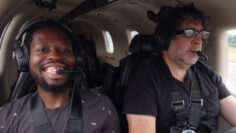Mysterious Abandoned Airfields of World War II

World War II left an indelible print, etching itself deeply into the collective human consciousness. An embodiment of that profound impact comes alive in the form of numerous airfields constructed across the globe. Once bustling with activity, these sites have transformed into ghost towns since the war ended, their sense of mystery growing with each passing year. These vestiges of the past attract a variety of individuals, from historians and explorers to those with a knack for unraveling the enigmatic.
Airfields, during World War II, were not just strips of land for takeoff and landing. They were arteries that pumped life into air campaigns, enabling strategic bombing runs, reconnaissance missions, and troop transportation. The role they played was so integral that their influence spread far and wide, providing key infrastructure to control the airspace, support ground operations, and pave the way for victory in critical battles.

The deserted airfields we stumble upon today can be bifurcated into two distinct types. Some of them, once thriving operational airfields, were forced into retirement by shifts in military strategy, rapid technological advancements in aviation, and the global efforts towards demilitarization after the war. On the other hand, certain airfields were the secret guardians of the war, meticulously camouflaged to outsmart the enemy. These covert sites were often hidden in plain sight, mimicking natural landscapes or ordinary civilian locations. With the war’s end, many of these secret airfields were abandoned, their enigmatic existence leaving behind tantalizing clues for us to piece together.
While these airfields are intriguing historical sites, they’ve earned their fame for something quite unconventional—being hotbeds for paranormal activity. Whispered tales of ghostly apparitions, inexplicable sounds, and an eerie ambiance have lent a spine-chilling quality to these airfields. There are also accounts of strange phenomena like unaccountable lights, peculiar sounds, and extraordinary atmospheric conditions that baffle logic.
However, these abandoned airfields, no matter their present state, carry a weight of historical importance that’s hard to overlook. Efforts have been made to preserve and revive these places. Various restoration projects have tried to reincarnate these sites, allowing visitors a peek into the annals of World War II aviation history. Museums dedicated to these airfields play a crucial role, exhibiting artifacts and educating visitors about their significance, ensuring that these places remain etched in our memory as reminders of a time marked by courage, sacrifice, and strategic brilliance.
WWII Abandoned Airfields: Notable Sites
RAF Binbrook in Lincolnshire, England, played a critical role in the defense of the United Kingdom and significant bombing missions. Its now-deserted runways and decaying hangars bear silent testimony to its vibrant past.
Berlin’s Tempelhof Airport was a significant hub for the German air force, and later, a symbol of the Berlin Airlift. The empty airport buildings and runways stand as mute witnesses to a time of turbulence and transition.
Clark Air Base in the Philippines, established by the US Army Air Corps, faced intense bombings during the Japanese invasion. Reclaimed by Allied forces, it was a base for crucial air operations. The abandoned runways and deteriorating infrastructure serve as a testament to the courage and sacrifice shown during the Pacific campaign.
RAF Manston, located in Kent, England, was one of the busiest airfields during the war. Its critical role in defending British airspace and supporting the 1940 Dunkirk evacuation still echo in its decaying runways and hangars.
Midway Atoll, a tiny island in the Pacific Ocean, witnessed a decisive battle that altered the course of the war. Its abandoned airfield was the launching pad for American aircraft that bravely engaged the Imperial Japanese Navy. Today, the remnants of the airfield stand as touching reminders of the sacrifices made during the Battle of Midway.
Echoes of the Past
These abandoned airfields are merely glimpses into the myriad forgotten sites etched into World War II history. Each location narrates a unique story, forever imprinted on the landscapes they occupy. An expedition to these deserted airfields provides an opportunity to touch the echoes of the past, honor the valiant souls who served, and immerse oneself in the tangible history that these places offer.
The ongoing endeavors to preserve and refurbish these airfields are pivotal in sustaining a physical link to our past for future generations. Museums dedicated to these airfields serve dual roles – as curators of historical artifacts and as educators providing a comprehensive understanding of the wartime experiences, technological breakthroughs of the era, and the strategic operations enacted on these grounds.
The Thrill of the Unknown
Adding a thrilling dimension to these historical sites are the legends and paranormal occurrences associated with these abandoned airfields. Tales of spectral apparitions, mysterious lights, unexplained sounds, and atmospheric anomalies contribute a layer of mystique to these sites. These stories continue to captivate our imagination, adding an additional sense of mystery and allure to these historical landmarks.
By sharing our discoveries and experiences related to these abandoned airfields, we cultivate a sense of community among history enthusiasts and explorers. This shared interest in unveiling the past ensures that these historical sites, and the stories they enshrine, will continue to be remembered.
FAQs (Frequently Asked Questions)
What were the main reasons for abandoning World War II airfields?**
The answer is complex and multidimensional. As the dust of war settled, and the world began its path towards recovery, the strategies deployed by the military evolved and adapted. Simultaneously, the realm of aviation was experiencing technological leaps that surpassed all prior expectations. Coupled with a worldwide movement towards post-war demilitarization, it’s no wonder that countless airfields were deserted, gradually fading into obscurity.
Are there any famous abandoned airfields that have been rediscovered?
Indeed, there are. One such instance that stands out is the “Lost City” airfield, a hidden treasure nestled in Papua New Guinea. Serving as a crucial bastion for Allied forces during the turbulent Pacific campaign of World War II, its rediscovery has spurred a renewed fascination in the roles these forsaken sites played on the global war stage.
Are all abandoned airfields accessible to the public?
The reality of this matter varies significantly. Many of these neglected airfields have been transformed into public entities such as parks and museums. They offer visitors a journey through history, complete with informational plaques and guided tours highlighting their role during World War II. However, accessibility isn’t universal. Some airfields are tucked away on private lands, others are off-limits due to safety hazards, and a few are currently engaged in preservation or restoration endeavors. Hence, it’s vital to verify the accessibility of a specific airfield before embarking on your adventure. Happy exploring!
Conclusion: Remembering the Sacrifices
The abandoned airfields of World War II serve as intriguing windows into our past. These forsaken sites, with their whispers of history and silent tales of valor and sacrifice, continue to captivate us. Through our endeavors to preserve, explore, and share their stories, we ensure that the deeds and sacrifices of those who served during World War II will continue to resonate through time.
Join the Conversation: Share Your Insights
We encourage you to contribute your thoughts and personal experiences with these abandoned airfields in the comment section below. Have you had the opportunity to explore any of these sites or heard captivating tales about them? If this article sparked your interest, think about sharing it with others who might also be captivated by World War II history and the allure of deserted places. Don’t forget to check out our recent piece on Flight Planning Simplified: Navigational Guidance for Pilots, where you can uncover handy tips and strategies to refine your flight planning and navigational proficiency.







